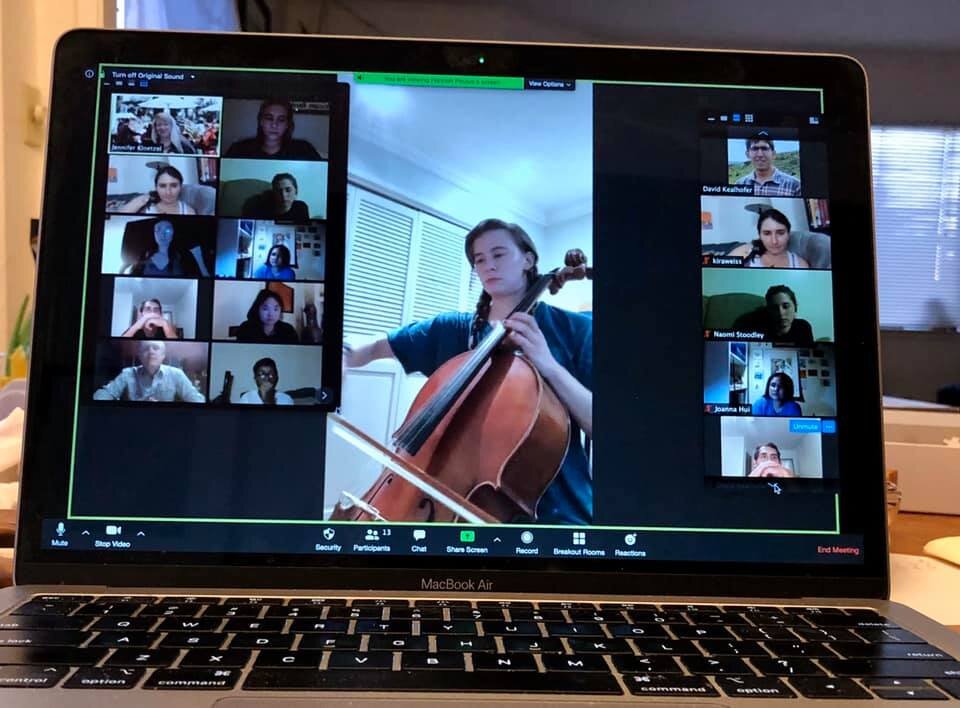By Raymond Matthews
UC Santa Barbara’s transition to online classes due to the COVID-19 pandemic has posed significant obstacles for both students and faculty. Online courses are especially challenging for those in the Music Department who are accustomed to in-person rehearsals and performances.
But professors within the department are coming up with new ways to make music from a distance, by applying online teaching methods to create virtual solo and chamber music sessions.
The annual “etude challenge” for student string musicians has moved online.
Jennifer Kloetzel, an assistant professor who teaches cello and heads the strings program, said that she and her students face difficulties with sound quality when working remotely. “A lot of the subtleties in the sound of string instruments are difficult to hear online which is a handicap for me as an instructor,” Kloetzel said. So she is trying new methods to adapt to an online format.
“I’ve been asking students to send in pre-recorded videos for me to review and we’re testing out different kinds of microphones just to see what works best,” she said. “We’re looking into getting better sound equipment like external microphones to get closer to studio quality sound. It’s definitely a challenge but we’re making it work.”
Kloetzel works with string ensembles who are now unable to play together in person, so her main challenge has been maintaining a group dynamic among students.
“Our chamber ensembles obviously can’t get together and perform live like they usually would so we’re trying to get creative with how to coordinate group performances online so that they can still work together as a whole,” she said.
One way Kloetzel did this was by moving her annual “etude challenge” — which allows students to perform short solo performances to a panel of judges and peers — to a digital format.
“Last year I started a group challenge called the etude challenge where students perform short musical compositions to show their technical skills,” she said. “So I brought in a judge and we did the challenge over Zoom and the judge, the competitors, and myself all got to watch everyone’s performances. The challenge worked well because everyone committed and worked hard to make it happen.”
While live video calls are useful, performing music with lackluster sound quality while staring at one’s audience through small, grainy video feeds can be taxing for both professors and students.
“What I find most difficult is that it’s much more exhausting so with staring at a computer without human interaction,” Kloetzel said. “I’m a little worn out after around four hours whereas in person I can teach for around eight or nine hours a day and be fine. But hopefully as we get used to performing remotely it will get easier,” she said.
Even though Kloetzel has done a lot to personally adapt her teaching style, she said that much of her students’ success with the online format is a tribute to their commitment to their craft.
“I’m really proud of my students for being super flexible and curious, they’re trying really hard to stay focused on their studies,” Kloetzel said. “With online classes it could easily go the other way and students could lose interest. But they’re staying on top of everything and making the most of a less than ideal situation.”
Shruthi Satyanarayana, who majors in biology and minors in music, said that the new online format has made it more difficult to work with peers and learn from instructors.
String ensemble practices over Zoom.
“A lot of the tonality and the little subtleties in the sound — especially for us violinists and string musicians — don’t come through over Zoom calls, so it’s difficult for my professors to give me feedback,” she said. “It’s also hard for ensembles to hear each other and work as a team, but we’re working on getting sound equipment like external studio quality microphones for students for just those reasons and I think that will be helpful.”
Satyanarana said that the main reason the online format has worked is because of the support that the Music Department’s professors have offered throughout the quarter.
“The professors have been handling this really well, they’ve been communicating with us even more than usual because they know that this is a challenging situation. So we’re really being kept up to date,” she said.
Maxim Kuzin, who directs the UCSB Chamber Orchestra as well as the Chamber Choir and the Women’s Choir, said that he has used Zoom lectures to teach his students practical skills that they wouldn’t otherwise get in a typical quarter.
Kuzin has taken time that would have been spent in concert rehearsal to prepare students for careers after college by holding mock auditions for professional ensembles and orchestras.
“I’ve taken this time to prepare students who are interested in pursuing careers in music for what formal auditions for orchestras will look like,” Kuzin said. “So we are doing mock auditions for students to emulate formal auditions in order to help them succeed as professionals, which isn’t something we can normally do since we spend most of the quarter preparing for final concerts; but the online format allows us to do this sort of thing which is really exciting.”
Kuzin said that communication among students, faculty and staff within the department has been a great asset.
“Everyone, from the department chair to lecturers and professors, has been in constant communication to keep students engaged and give them the best quality experience that we can,” he said.
Raymond Matthews is a third year Political Science major at UC Santa Barbara. He is a Web and Social Media Intern for the Division of Humanities and Fine Arts.



